So, I’m not just writing this article because this is my favorite Disney film and I want to gush about it, but I find it a relevant film to talk about during quarantine. For those few who don’t know the story, Hunchback of Notre Dame is about Quasimodo (Tom Hulce), a deformed bell-ringer who yearns to be free from his sheltered life inside Notre Dame Cathedral, but has to stay away from society because his master, Judge Claude Frollo (Tony Jay), forbids it.
Quasimodo is a character whom we can all relate to right now. He wants to get out there, and his song “Out There” is a powerful number that emphasizes his desire to belong. His desire to be free from the restrictions that has bound him for 20 years.
Now, if Quasimodo is able to handle isolation inside a dark cathedral for that long, we can handle this quarantine. We can do it, everyone.
Anyhow, “Quasi” manages to leave his confinement and goes to a festival called the Feast of Fools. He’s crowned the King of Fools as everyone believes that he’s wearing a hideous mask, but when it’s revealed that it’s not the case, he’s humiliated. Quasi’s tied up, insulted, and has food thrown at him.
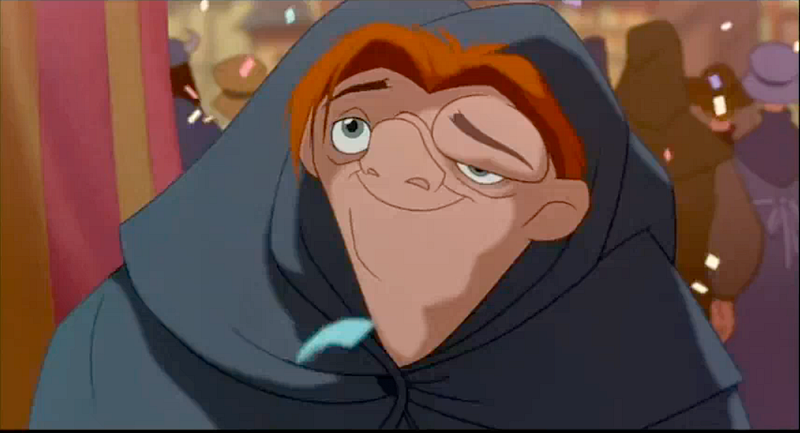
Quasimodo is a character that you sympathize for, you want him to be loved as he’s known nothing but cruelty throughout his life. His deformity shuts him away from society, and only made it worse when the crowd tortures him. Fortunately, he’s saved by the gypsy, Esméralda(Demi Moore). Esméralda is the first person to show Quasimodo kindness, and so he falls for her.
Another character who falls for Esméralda, but in a different way, is Frollo. Frollo is a cruel man who, in the first five minutes of the film, kills a woman and almost drowns her baby in a well. Did I mention this is rated G? Yeah, how did that happen? I don’t know, but I find it hilarious that one of Disney’s darkest films has a G rating.
Despite Frollo being such an evil person, he has the best villain song. “Hellfire” is a visually stunning musical number where Frollo is in conflict with himself over his lust for Esméralda. He wants her, but he’ll burn her at the stake if she doesn’t want him. This is definitely not a song that Disney would make today.
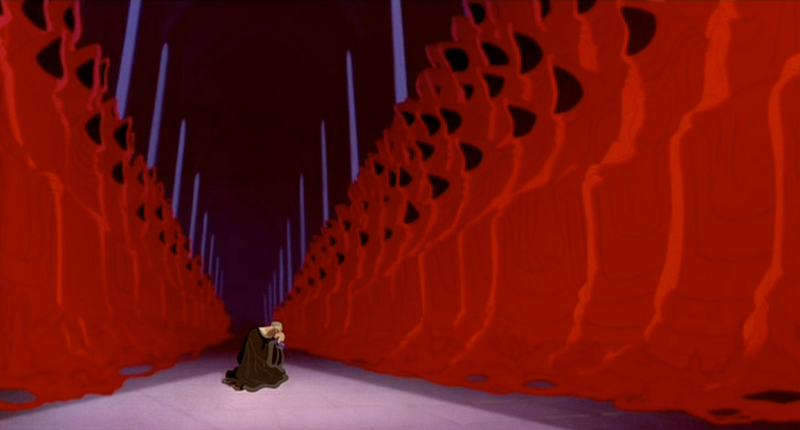
Lyrically haunting and intense, “Hellfire” is filled with religious symbolism including hell, of course. Frollo is infatuated over Esméralda, but he swears that he’s a righteous man of God. He’s devoted to his faith, but temptation gets the better of him. Frollo claims that God made the devil stronger than man, attempting to justify for his sins. Again, it’s an intense song that cements Frollo as one of Disney’s greatest villains.
Quasimodo also sings about Esméralda in a song called “Heaven’s Light”. However, Quasimodo sings about love rather than lust, and he sings it with passion rather than twisted temptation. Everyone talks about “Hellfire” (and rightfully so) but rarely about “Heaven’s Light” which serves as a great juxtaposition to the latter.
Quasimodo describes Esméralda as an angel and hopes that she cares about him as he does for her. While he sings, he sculpts a miniature of Esméralda which is sweet. Unfortunately, Frollo destroys the miniature by lighting it on fire — which is exactly what he wants to do with her.
Quasimodo and Frollo both have strong feelings for Esméralda, but neither of them get her in the end. This is one of the few Disney films where the main character doesn’t get together with someone, but that’s not what the movie’s about. It’s about acceptance, seeing the good within someone without judging appearances.
Esméralda was the first person to look past Quasimodo’s appearance, show him kindness and show that there’s beauty in the world. In the end of the film, Quasimodo’s accepted into society thanks to her.
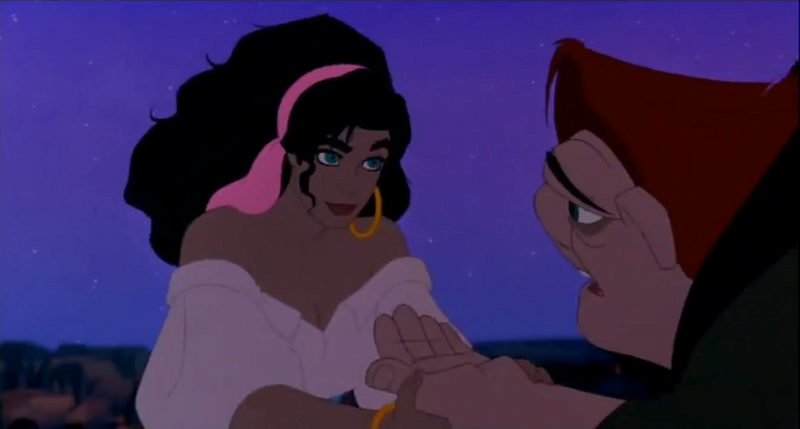
Esméralda is depicted as beautiful to the point that she’s sexualized, particularity in the “Hellfire” sequence when a silhouette of Esmerelda dances within flames. Though, the sexualization is kind of the point, since her appearance drives Frollo’s obsession.
Esméralda is more than just beautiful, she’s clever, sassy, but more importantly, she’s caring. Her song, “God Help the Outcasts” depicts how much she wants her people — the Romani — and others to be saved. It’s one of the film’s most poignant songs, establishing Esméralda as a selfless person who wants the best for the poor. While a majority of Disney heroine songs are about themselves, Esméralda sings for others.
Again, Esmérald ahas character. She’s not just a pretty face. She’s independent but she does end up with the other protagonist, Phoebus (Kevin Kline) because it’s a Disney movie, there has to be at least one pairing by the end of the film.
In speaking of Disney, we have to talk about the gargoyles…
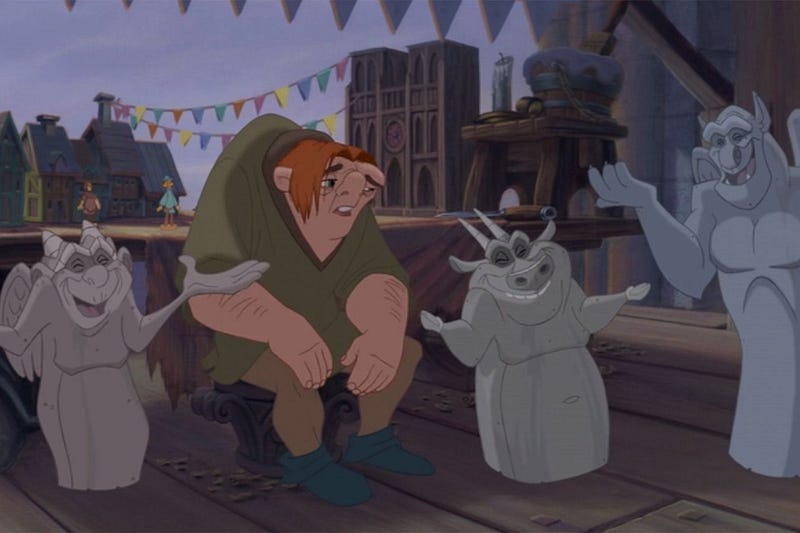
The gargoyles serve as comic relief for the film, which would’ve been appropriate if they weren’t so annoying. On one hand, if you kick out the gargoyles, you’re going to be scarring kids through out the film. On the other hand, the gargoyles present to us awkward tonal shifts, especially when they sing a song while Paris is on fire.
Now, the gargoyles aren’t the worst things from a Disney film, but they do remind you that, “Hey, this is a Disney film, so we gotta do something silly for the kiddies” and it can be, well, silly. The movie brings out heavy themes such as lust, religion, prejudice, etc, and so it’s awkward when we cut back to the gargoyles who stick out like sore thumbs.
Besides that, that’s my only negative of the film. Now I’m aware that the film doesn’t really follow Victor Hugo’s book and that should also be a negative, but considering that I haven’t finished the novel yet, I’m going to separate the novel from the movie and treat them as their own things.
Though, if there’s one difference that I want to mention, Quasimodo is treated much better in the film than in the book. Rather than getting food thrown at him at the festival, Quasi is whipped, and kids definitely wouldn’t want to see that.
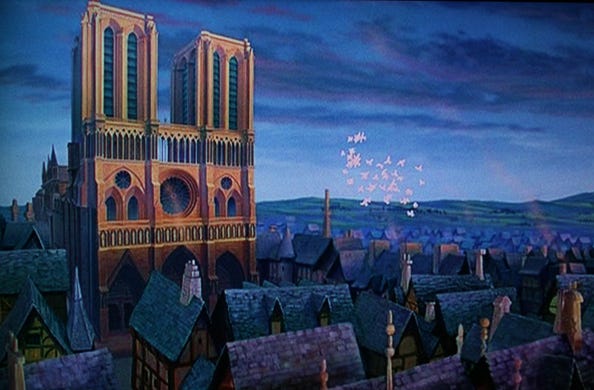
Disney’s Hunchback of Notre Dame is a unique film coming from the same studio that brought us The Little Mermaid and Aladdin. While it does have its silly moments to maintain Disney’s family-friendliness, it also carries themes that stick to audiences years after its release.
It was risky for Disney to make this sort of film, and they haven’t made another quite like this one. Nowadays, Disney plays it safe. They avoid stepping out of their comfort zone in fear that they’ll offend their audiences. Guess you could say they’re not getting…out there.


Comments